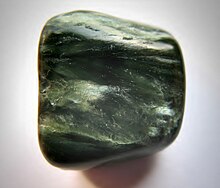Seraphinite
Trade name for a form of clinochlore From Wikipedia, the free encyclopedia
Trade name for a form of clinochlore From Wikipedia, the free encyclopedia
Seraphinite is a trade name for a particular form of clinochlore, a member of the chlorite group.
| Seraphinite | |
|---|---|
 Seraphinite specimen | |
| General | |
| Category | Seraphinite mineral |
| Formula (repeating unit) | (Mg, Fe3+Al(Si3Al)O10(OH)8 |
| Crystal system | Monoclinic |
| Identification | |
| Color | green, white, colourless |
| Mohs scale hardness | 2–2.5 |
| Luster | Pearly, dull, greasy |
| Streak | light green |
| Diaphaneity | transparent, translucent to opaque |
| Specific gravity | 2.600–3.000 |
| Optical properties | Biaxial (–) |
| Refractive index | 1.571–1.597 |
| Birefringence | 0.005–0.011 |
| Ultraviolet fluorescence | inert |
Seraphinite apparently acquired its name due to its resemblance to feathers due to its chatoyancy. Seraphinite is named after the biblical seraphs or seraphim angels.[1] With some specimens the resemblance is quite strong, with shorter down-like feathery growths leading into longer "flight feathers"; the resemblance even spurs fanciful marketing phrases like "silver plume seraphinite." Seraphinite is generally dark green to gray in color, has chatoyancy, and has hardness between 2 and 4 on the Mohs scale of mineral hardness.
Seraphinite is mined in a limited area of eastern Siberia in Russia. Russian mineralogist Nikolay Koksharov (1818-1892 or 1893) is often credited with its discovery. It occurs in the Korshunovskoye iron skarn deposit in the Irkutskaya Oblast of Eastern Siberia.[2]
Seamless Wikipedia browsing. On steroids.
Every time you click a link to Wikipedia, Wiktionary or Wikiquote in your browser's search results, it will show the modern Wikiwand interface.
Wikiwand extension is a five stars, simple, with minimum permission required to keep your browsing private, safe and transparent.